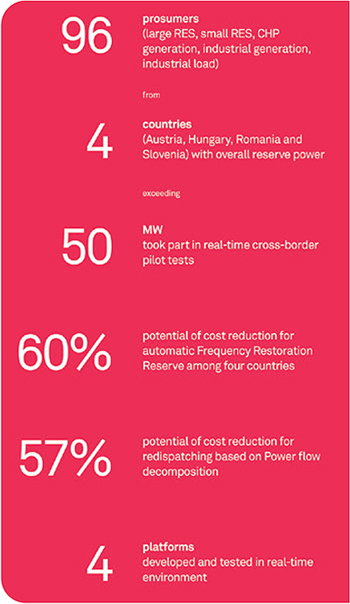The FutureFlow project has resulted in allowing the extraction of all flexible resources which are available in the power system. This will assist TSOs in achieving the goal of offering direct market access to all resources and confirm their position as being the most reliable "system frequency manager" for now and the future.
The evolution of the energy market towards a system with bulk generation from geographically concentrated wind and solar power, with a large part of it connected to voltage levels out of direct TSO control, requires solutions like FutureFlow to process the tremendously higher number of inputs and outputs from which the frequency signal will be dependent.
By FutureFlow, the electrical energy market is achieved in its ultimate form. The solution brings the full transparency on the available system flexibility. The coordination between balancing and redispatch resources cross-border and over different voltage levels have been prevented by the lack of a targeted business solution to favor their market access and their transparent contribution to system frequency, congestion resolution and voltage regulation.
 Now, with FutureFlow, the features of energy market coupling for a day-ahead and intraday are compressed into a timeframe of a few minutes. These functionalities are integrated with the latest achievements reached by TSOs for optimizing the calculation and sharing resources for operational reserve and redispatch across control zones. The sharing of resources is not limited to those available at transmission level but can potentially reach all distributed generation and demand side resources connected to the grid, at whatever voltage level. It is thanks to these features that FutureFlow achieves the maximum extraction of social welfare from almost real-time markets, including heavily congested systems.
Now, with FutureFlow, the features of energy market coupling for a day-ahead and intraday are compressed into a timeframe of a few minutes. These functionalities are integrated with the latest achievements reached by TSOs for optimizing the calculation and sharing resources for operational reserve and redispatch across control zones. The sharing of resources is not limited to those available at transmission level but can potentially reach all distributed generation and demand side resources connected to the grid, at whatever voltage level. It is thanks to these features that FutureFlow achieves the maximum extraction of social welfare from almost real-time markets, including heavily congested systems.
As a direct consequence, the flexibility price has a clear chance to become the real price of wholesale electricity for the European market. The text of the Energy Regulation 2019/943 indicates full marginal pricing for balancing and imbalances as the reference pricing practice. However, to avoid price distortions, the overarching and detailed view on the actual volume of generation and demand to modulate the frequency signal is the only acceptable precondition to deliver transparent and cost-reflecting market prices. FutureFlow gathers this view from traditional balancing service providers and from all.
VPP structures that have been modelled and tested on ground for this project. This has created a composite library of business cases and solutions that can be used for industrial applications in areas where the flex potential of, e.g. small hydro, has been largely untapped, thus allowing the fast and quick inclusion of the VPP flexibility into the market.
For TSOs the unprecedented results of this project pave the way to the solution of other severe issues which have been proving difficult to solve until now, even with the increasing support of RSCs.
In this respect, FutureFlow works as a power system "telescope", gathering a much broader and much more detailed view on available generation and demand-side resources to determine system security perimeter every 15 minutes for the coming day...
The tool could furthermore provide increased precision for cross zonal capacity calculations - with borders adapting more flexibly to congestions (no matter if internal or cross-border) for each 15-minutes market terms, as well as for calculating well-rounded cross-border cost allocations for PCI – including the effect of balancing markets in the CBCA assessment.
Thanks to its features, FutureFlow can become a cornerstone solution for the ultimate market integration of distributed generation and demand side as well as becoming a key tool for grid operators to tackle the challenges of the evolving European power system.
Contact details:
For more information, please visit: www.futureflow.eu/
This project has received funding from the European Union's Horizon 2020 research and innovation programme under grant agreement No 691777.